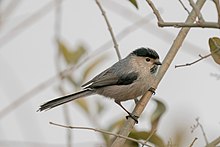The silver-throated bushtit or silver-throated tit (Aegithalos glaucogularis) is a species of passerine bird in the family Aegithalidae, widespread throughout the temperate forests of Central, East and parts of North and Western China. The bird's native habitats are mainly along the middle/lower Yangtze and Yellow River basins, although there is also a small southwestern habitat extension in Yunnan along the Lancang valley within the Hengduan Mountains. It has two recognized subspecies.
| Silver-throated bushtit | |
|---|---|

| |
| A. g. vinaceus, Weifang, Shandong Province, China. | |
| Scientific classification | |
| Domain: | Eukaryota |
| Kingdom: | Animalia |
| Phylum: | Chordata |
| Class: | Aves |
| Order: | Passeriformes |
| Family: | Aegithalidae |
| Genus: | Aegithalos |
| Species: | A. glaucogularis
|
| Binomial name | |
| Aegithalos glaucogularis (Gould, 1855)
| |

| |
History
editA paper on the silver-throated bushtit by the English naturalist Frederic Moore was read at a meeting of the Zoological Society of London on 27 June 1854.[2] The English ornithologist John Gould then included the silver-throated bushtit in his book The Birds of Asia and cited Moore's paper. Gould used Moore's specific name but a different genus to obtain the binomial name Mecistura glaucogularis. He specified the type locality as Shanghai.[3] As Gould's work appeared in print in 1855 before the publication of the proceedings of the Zoological Society, under the rules of the International Code of Zoological Nomenclature Gould's publication has priority.[4] The name glaucogularis combines the Latin glaucus "glaucous" and the Neo-Latin gularis "throated".[5]
Taxonomy
editThe silver-throated bushtit was formerly considered a subspecies of the long-tailed tit (Aegithalos caudatus) but its plumage is distinctive and there are significant genetic differences.[6][7]
Two subspecies are recognized:[8]
- A. g. glaucogularis (Gould, 1855) – the nominate subspecies, native to the middle/lower Yangtze basin in Central East China
- A. g. vinaceus (Verreaux, J, 1871) – the northern/subalpine subspecies, native to the Yellow River basin in North China with habitat extensions into western Liaoning, central Gansu, eastern Qinghai, western Sichuan and Yunnan
References
edit- ^ BirdLife International (2016). "Aegithalos glaucogularis". IUCN Red List of Threatened Species. 2016: e.T103871974A104153820. doi:10.2305/IUCN.UK.2016-3.RLTS.T103871974A104153820.en. Retrieved 20 November 2021.
- ^ Moore, Frederic (1854). "Descriptions of three new species of titmice". Proceedings of the Zoological Society of London. 22 (268): 139–140 [140]. doi:10.1111/j.1469-7998.1854.tb07255.x. The title page of the issue gives the year as 1854 but it was published in 1855.
- ^ Gould, John (1855). The Birds of Asia. Vol. 2. London: self. Plate 69 and text.
- ^ Dickinson, E.C.; Christidis, L., eds. (2014). The Howard & Moore Complete Checklist of the Birds of the World. Vol. 2: Passerines (4th ed.). Eastbourne, UK: Aves Press. p. 509 Footnote 2. ISBN 978-0-9568611-2-2.
- ^ Jobling, J.A. (2018). del Hoyo, J.; Elliott, A.; Sargatal, J.; Christie, D.A.; de Juana, E. (eds.). "Key to Scientific Names in Ornithology". Handbook of the Birds of the World Alive. Lynx Edicions. Retrieved 24 March 2018.
- ^ Harrap, S (2018). del Hoyo, J.; Elliott, A.; Sargatal, J.; Christie, D.A.; de Juana, E. (eds.). "Silver-throated Tit (Aegithalos glaucogularis)". Handbook of the Birds of the World Alive. Lynx Edicions. doi:10.2173/bow.lottit5.02. Retrieved 24 March 2018.
- ^ Päckert, M.; Martens, J.; Sun, Y.-H. (2010). "Phylogeny of long-tailed tits and allies inferred from mitochondrial and nuclear markers (Aves: Passeriformes, Aegithalidae)". Molecular Phylogenetics and Evolution. 55 (3): 952–967. doi:10.1016/j.ympev.2010.01.024.
- ^ Gill, Frank; Donsker, David, eds. (2017). "Bushtits, leaf warblers, reed warblers". World Bird List Version 8.1. International Ornithologists' Union. Retrieved 21 March 2018.
External links
edit- Xeno-canto: audio recordings of the silver-throated bushtit
- Media related to Aegithalos glaucogularis at Wikimedia Commons
- Data related to Aegithalos glaucogularis at Wikispecies
